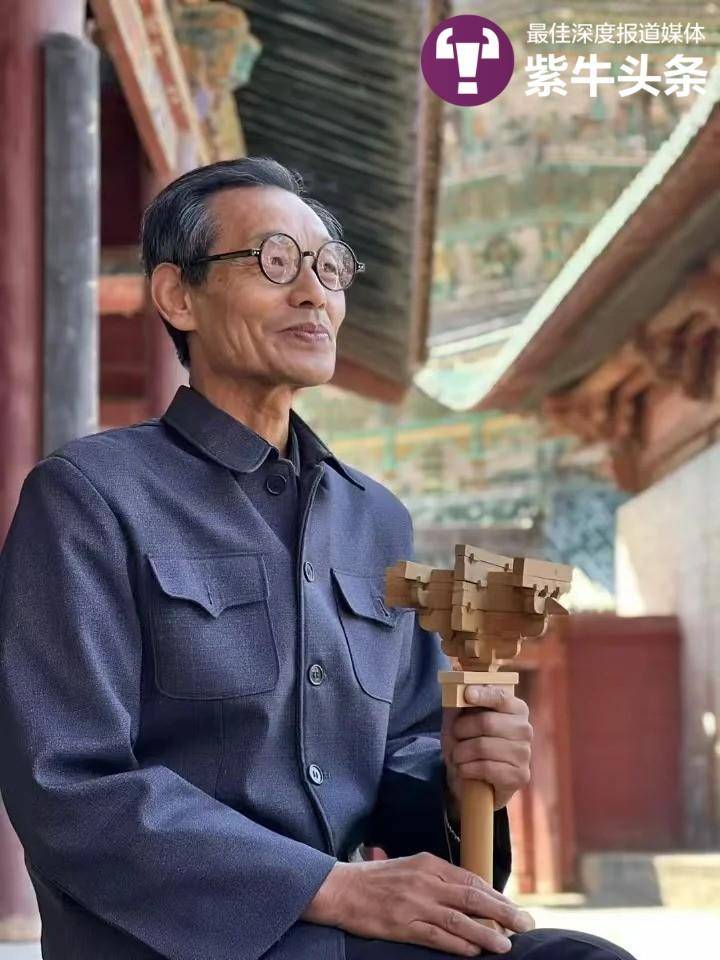74-year-old 'Dougong Grandpa' popularizes ancient Chinese architecture through short videos
Wang Yongxian, a 74-year-old Chinese expert in the restoration of ancient Chinese buildings who has restored over 100 precious ancient buildings, is leveraging short-video platforms to introduce the architectural characteristics of ancient buildings in north China's Shanxi Province to internet users.
Since 2019, Wang has been posting videos about ancient Chinese buildings on popular Chinese short-video platforms under his personal accounts with names featuring Dougong, one of the most important elements in traditional Chinese architecture and also a unique structural element of interlocking wooden brackets.
He has so far posted over 170 videos in a collection titled "Learn ancient architecture basics from scratch", claiming over a million followers and over 20 million views. Many of his videos have garnered hundreds of thousands or even millions of views.

Photo shows Wang Yongxian, a 74-year-old Chinese expert in the restoration of ancient Chinese buildings. (Yangtse.com/courtesy of Wang Yongxian)
Most of his followers are young people, who affectionately call him "Dougong Grandpa."
"Dougong is the soul of ancient Chinese architecture, so I use it in my online account usernames," Wang explained.
His videos have garnered warm responses among internet users.
Many netizens left comments or sent him private messages, thanking Wang for enabling them to finally understand the intricacies of ancient architecture and expressing their strong desire to visit Shanxi and admire the ancient buildings.
Some netizens even watch his videos as a "crash course" before touring Shanxi.
There are also students who developed an interest in ancient Chinese architecture after watching Wang's videos and got into the graduate program in architectural history at China's prestigious Tsinghua University.
Wang is pleasantly surprised and gratified by young people's growing interest in ancient Chinese architecture.
"Over the years, China has been placing increasing emphasis on the protection of ancient architecture, and more and more people are starting to pay attention to ancient buildings. I feel sincerely happy seeing the large number of young people progress from not understanding to developing a basic understanding, and eventually coming to love ancient buildings," Wang said.
"I have had an inseparable bond with ancient buildings throughout my life. Now, I feel deeply gratified to contribute a little to the dissemination of ancient architectural culture," he said. "Although I'm old now, I still want to make use of my expertise."
Wang's connection with ancient Chinese buildings began over 50 years ago. In the early 1970s, Wang joined the cultural relics working committee of Shanxi Province and became a "temple repairman".
"Ancient buildings were previously called temples, mostly located in rural areas. Temple repairmen led lives comparable to ascetics, with little time spent with family, and spent years in remote and desolate mountains, surveying and restoring, reviving temples on the brink of collapse," Wang recalled.
Thanks to the painstaking efforts of Wang and his colleagues over the decades, an increasing number of ancient buildings across Shanxi, such as Foguang Temple, Chongfu Temple, Guandi Temple, Jinci Temple's Shengmu Hall (Holy Mother Hall), and Xuankong Temple, have been revitalized and opened to the public.
After retiring from his job, Wang's love for ancient architecture has not diminished a bit. He immersed himself in research, learned woodworking techniques, created models of Dougong, and published many monographs and papers.
In 2017, Wang was hired to work as a lecturer at Taiyuan Normal University in Taiyuan, capital of Shanxi Province, teaching courses on the restoration and preservation of ancient architecture to students.
As he got to know his students better, Wang found that these young students were more interested in foreign cultures than in Chinese culture, which motivated him to bring traditional Chinese culture closer to the youth of today.
"As a protector of ancient architectural culture, I believe it is my responsibility to help young people understand our excellent traditional Chinese culture and our ancient architectural culture," Wang said.
It was casual conversations with students during break time that inspired him to use short videos to popularize knowledge about ancient Chinese buildings, he said.
In February 2019, Wang joined short-video platforms with his family of three. He is responsible for providing professional explanations and writing scripts, while his wife shoots the videos and their daughter takes care of the editing.
In order to cater to the tastes of young people and help them more quickly embrace ancient architectural culture, he began appearing in person in the videos and created a series of videos focusing on specific subjects.
By delving into details on site, utilizing ancient professional books, dissecting models of Dougong in ancient buildings, showing hand-drawn illustrations, demonstrating construction practices, and leveraging educational animations, among other methods, he engaged deeply with netizens, answering their questions.
In an effort to conduct more on-site filming, he obtained a driver's license at the age of 72, and has frequently traveled around various parts of Shanxi to explain different architectural characteristics of ancient buildings through short videos.
Although each video episode he posts is only two to three minutes long, it requires a significant amount of time and effort behind the scenes, according to Wang.
"The journey for shooting each video often lasts over 10 days, during which we visit one temple after another. Long hours of driving can be exhausting. The filming often goes late into the night, leading to irregular meals. Every time I return from a video-shooting journey, I lose several kilograms," Wang said.
Despite the challenges, Wang takes great pleasure in his endeavor.
"My explanations and educational content can help more people appreciate the beauty of Chinese ancient architecture, bringing cultural relics to life and igniting interest. This is what I want to do," he said.
Wang admitted that at times, he envied his peers' leisurely lifestyle, feeling a slight wavering within himself. However, deep in his heart, he feels a sense of mission and responsibility to impart his knowledge about ancient architecture to the next generation.
The encouragement from many netizens also serves as his driving force, Wang noted. "Though the process is challenging, I find great joy in my efforts, and I have realized my life's value in this way," he said.
Currently, Wang is formulating a restoration plan for the Sakyamuni Pagoda of Fogong Temple in Yingxian county, Shanxi Province. The pagoda, which is well known as the Wooden Pagoda of Yingxian county, is the tallest all-wooden structure tower in the world that still exists.
Wang often motivates himself with the famous Chinese poet Zang Kejia's verse, "Even an old ox values the preciousness of time, without needing a whip, it propels itself forward."
"As long as my body allows, I will continue to shoulder this cultural mission," he said.
Photos
Related Stories
- Trending in China | Stilt houses: Diaojiaolou
- Architects collaborate with rural artisans to build, improve wooden architectures in SW China's Guizhou
- Art season launched to showcase Beijing's ancient architecture
- From A to Z: Unveiling Shanghai's Architectural Marvels
- Lin Huiyin: Century-long journey to her UPenn degree
- The charm of ancient Chinese architecture
- East China's Anhui hosts forum to boost development, protection of ancient Hui architecture
Copyright © 2024 People's Daily Online. All Rights Reserved.









